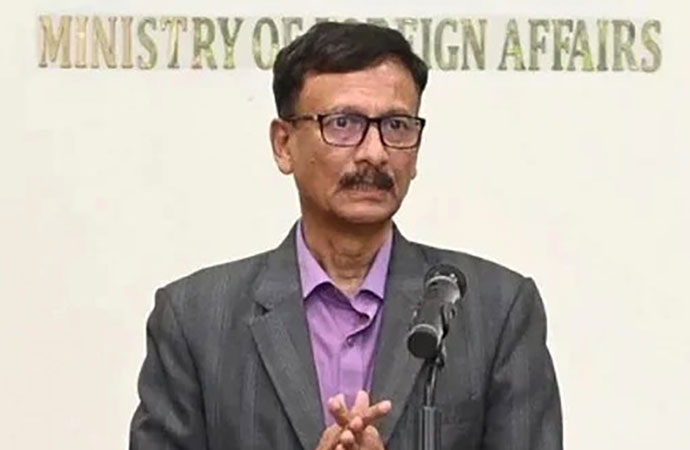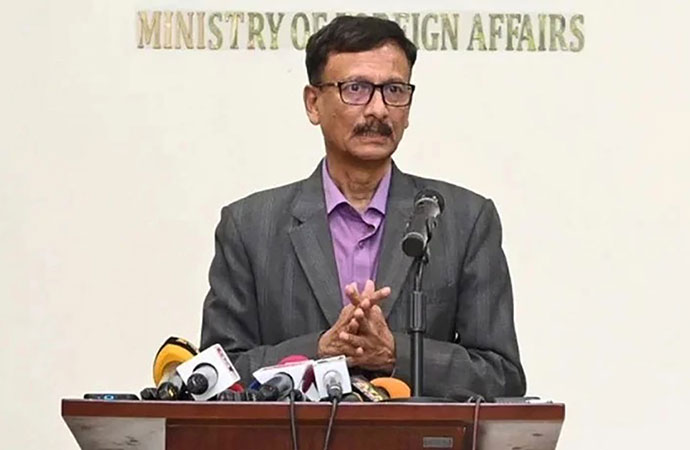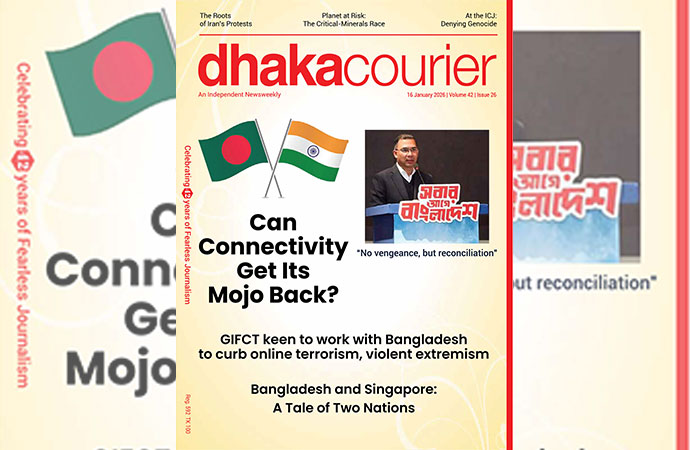Reportage

Bangladesh Prime Minister Sheikh Hasina shaking hands with Indian Prime Minister Narendra Modi before beginning of the bilateral talks between the two countries at Hyderabad House in New Delhi on Saturday, Oct 5. - PID photo
DHAKA: Prime Minister of Bangladesh Sheikh Hasina will be visiting India from October 3 to 5. After attending the India Economic Summit of the World Economic Forum in New Delhi on October 4, she will have bilateral talks with Prime Minister Modi on October 5. Her last official visit to New Delhi was in April 2017 while Mr Modi visited Bangladesh in May 2015. So, at this point on the eve of her visit, it would be pertinent to take stock of where Bangladesh-India relations stand today.
Since Sheikh Hasina's game changing visit to India in January 2010, bilateral relations have been reconfigured phenomenally, in qualitative and substantive terms. The two countries amicably resolved, completely, their long festering land boundary dispute and equally long troubling maritime border dispute; trade has registered a quantum jump, with Bangladesh exports to India having crossed the psychological US $1 billion mark; India has extended over US $8 billion line of credit to Bangladesh, of which US $200 million of the first tranche was converted to outright grant while most of the rest will feed into massive infrastructure development projects, restoring historical connectivity that had been closed following Partition in 1947, and power projects for Bangladesh's energy security.
The two prime ministers enjoy excellent personal rapport. If India today has one good friend standing steadfastly by its side in her often-troubled neighbourhood, it is Bangladesh. So, what could go wrong? Several things.
What could still inject jarring tones and notes into this narrative are matters of public perception and mismatched expectations, more on the Bangladesh side than India's perhaps (but that could well be a matter of hyper-sensitivity on the part of one and relative absence of it in the other!). For starters, the unresolved matter of Teesta waters sharing is galling for Bangladeshis across the political divide (a MoU was inked by the Water Resources Secretaries of India and Bangladesh in December 2010 but was never signed by the respective Ministers because of obstruction by the government of West Bengal). Since September 2011, this matter has grown and dominates the narrative, both loud and whispered, of naysayers in Bangladesh skeptical of India's intentions and opposed to seeing any good coming from bilateral relations being strengthened further.
Bangladesh was also disappointed when India appeared to back away, after having accepted in 2010, the principle of addressing questions of shared rivers on a basin-wide basis (that is, graduating from rigid bilateralism to including Nepal in talks on the Ganga and Bhutan in talks on the Brahmaputra).
The launching of the BBIN process has almost lurched to a halt with the BBIN MVA (Bangladesh-Bhutan-India-Nepal Motor Vehicles Agreement), inked in May 2015, still remaining unratified by Bhutan even though the other signatories have completed ratification, completed trial runs along identified routes and agreed to the SOPs to govern movement of passenger and cargo traffic. Result, the MVA is yet to be fully operationalised. There is another unintended consequence from this stalling of the BBIN MVA-increasingly, (and I grant irrationally) people are beginning to view BBIN MVA as a ploy engineered by India to ensure achievement of its long cherished goal of transit and transshipment facilities through Bangladesh; now that it is happening bilaterally, mischievous people feel India is not really bothered if Bhutan stymies the process. Both Bangladesh and India would do well by working together to assuage whatever fears Bhutan may have and assure that while ratifying the quadrilateral agreement, it need not operationalise it until it feels reasonably comfortable doing so.
This stalling of the BBIN MVA has stymied progress on other ambitious goals set by the BBIN joint working group as far back as 2016: such as working towards integrated railways connectivity sub-regionally, an integrated sub-regional waterway, and energy and digital connectivity.
However, addressing issues related to common rivers as shared commons (basins) still appears a far cry because of perceived (and incomprehensible to Bangladeshis) reluctance on India's part. Similarly, India's long silence on Bangladesh's desire to build a Ganga Barrage within Bangladesh has perplexed Bangladeshis. It has now, after years of internal debate within Bangladesh, been placed at the top of the agenda in Bangladesh's Delta Plan, an ambitious blueprint that the ruling party hopes will be its defining legacy (and pathway to continuation) in power in the future. At the very least Bangladeshis, whether in or out of government, will hope there will be no foot-dragging by India.
In the meantime, a couple of other issues have catapulted to the fore in the last three years, and are likely to severely damage the fabric of bilateral relations if not addressed meaningfully, and quickly. Foremost among these is the problem of Rohingya refugees from Myanmar now guests, perforce, in Bangladesh. This refugee crisis is evocative of why 10 million Bangladeshis fled the genocidal onslaught by a brutalizing Pakistani army in East Pakistan in 1971 and sought sanctuary in India. Prime Minister Sheikh Hasina and the people of Bangladesh, not unmindful of their own previous crisis and India's generous treatment, opened their arms to give the traumatised Rohingyas refuge inside Bangladesh.
But India and China are both perceived as having stabbed Bangladesh in the back. Public perception of India and China's unhelpful stand continues to fester and grow, more so against India than China which has played its PR cards far more skilfully than India. India's seemingly knee-jerk response in favour of Myanmar (that militated against Bangladesh), reportedly in response to Myanmar's allegations of Islamist terrorists (Arakan Rohingya Salvation Army) attacking and killing Myanmar's police (which some intelligence experts have suspected could well have been carried out by Myanmar's own agencies to justify their contemplated actions), was viewed by a broad swathe of Bangladeshis as being Pavlovian in nature responding to key words "Islamist terrorists".
Over the last two years (since the Rohingya influx took place), frustration over Myanmar's flagrant obduracy and apparent continued support from China and India has deepened Bangladeshi resentment. This is particularly directed against India but there are some questioning China as well (though China's image in Bangladesh is better than India's). There is no TV channel or media outlet that does not feature a discussion on this subject on a continuing basis and the net fallout is toxic for Bangladesh-India relations.
The second issue is that of the NRC conundrum in Assam and some fairly incendiary remarks on illegal migrants (or termites, as unfortunately described by India's Union home minister), that has raised the decibel level in questioning Indian intentions towards Muslim Bengalis delisted as citizens by the NRC and speculation about their likely fate. The ramifications of this widening groundswell of public apprehension were taken seriously enough by the government. Sheikh Hasina raised the matter personally with Mr Modi in New York, reportedly for the first time. Despite soothing noises by Mr Modi, the sense of disquiet remains. In all likelihood, Prime Minister Sheikh Hasina will raise it officially during official talks, if for nothing else than to formally inject the sense of apprehension felt by her people into the Indian record (and to convey to her own people that she was not silent!).
Unfortunately, on top of the above, a development internal to India has deepened Bangladeshi disquiet and skepticism, and this is the recent actions relating to Jammu and Kashmir. Bangladeshis till now had paid scant attention to Kashmir. They had long felt, when part of Pakistan, that they were being used by Islamabad as a convenient cat's paw. In 1971, Bangladeshis kicked in the teeth the infamous "two nation" thesis as the basis for state formation and walked away from Pakistan to form their own nation state. But in drawing rooms and in media across Bangladesh, the abrogation of Article 370 has suddenly become a topic of heated discussion. Coming as it does in the wake of widely reported media stories of lynching of Muslims and the cow-slaughter ban issue across several Indian states, Bangladeshi hearts are suddenly bleeding and many see India validating the "two nation" thesis it had decried so robustly for 70 years.
All politics is local is an oft-repeated truism but in South Asia with its bitter Partition legacy, the distinction between local and regional is blurred and fuzzy. Sheikh Hasina is perhaps the most astute politician that Bangladesh has produced to date and a true inheritor of the mantle of her illustrious father, the Late Bangabandhu Sheikh Mujibur Rahman. Like her father, she has her finger (and instincts) honed to the pulse of her people. She cannot remain undisturbed by this latest development.
India and its leaders would do well to remember that despite Partition, some strands or remnants of the umbilical cord remain attached to the main body. The neo-Westphalian states in South Asia that were birthed so violently in the post-colonial disorder that emerged after World War-II, while having uneasy to hostile relations with each other, still react to what is happening across each other's borders for good or bad.
The author was High Commissioner of Bangladesh to India between August 2009 and October 2014. He was the Deputy High Commissioner in New Delhi from June 1984 to August 1988. Views expressed in this article are personal.

























Leave a Comment
Recent Posts
Remembering Kalidas Karmakar ( ...
The art world remembers Kalidas Karmakar, a visionary whose creativity ...
An Evening with Shishir Bhatta ...
Cosmos Art Echo, the artist talk initiative of Gallery Cosmos and Cosm ...
Myanmar denies genocide, calls Rohingya crackdown co ..
Yes, of course
Earth’s average temperature last year hovered among ..
Bangladesh and Singapore: A Tale of Two Nations